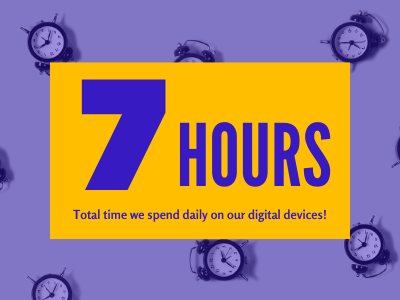In 1971, Herbert Alexander Simon famously coined the term “attention economy” to describe a phenomenon he saw rising out of the information age. Following the laws of supply and demand, Simon suggested that it is inevitable that a “wealth of information will create a poverty of attention”. In other words, an overabundance of digital information fueled by immediacy of access (mobile) will leave consumers with more information than can ever possibly be consumed, no matter how hard they try (with more than 7 hours a day spent on digital devices, it seems we’re trying very hard!).
“A wealth of information will create a poverty of attention.”
—Herbert Alexander Simon
This concept is particularly interesting because of the way in which it flips the customary way we think about the advertiser-consumer relationship. Traditionally, the “consumer” is viewed as the demand source (i.e., “consuming”) and content the supply. But in the attention economy the tables flip, and the content is the demand and consumer attention the supply.
What does this mean for brands, advertisers, and marketing professionals? It’s time we turn our eyes on the value of consumer attention and how we can better monetize it. Whether marketers know it or not, they have been monetizing attention for a long time — it’s just that the model has been so inefficient they probably didn’t realize it. For example, in the current ad model the more eyeballs a publisher can draw (attention) the higher the value of their ad space. Thus, greater value for more attention. But because it takes millions of impressions to get a couple hundred “clicks” (engagement) it doesn’t seem like we are monetizing attention as much as we’re paying for clicks.

(See how we spend our time. Get the FREE New Attention Economy infographic here.)
However, when information overload puts enough pressure on consumer attention, the market hits a tipping point and marketers are forced to find more efficient ways and methods by which to extract and measure consumer attention. This pressure is only compounded by things like ad blindness, ad fraud, and ad blockers, for example, which make it harder to reach more actual humans. This results in advertisers being forced to spend more and more money every year to reach fewer and fewer people. Something has to give because eventually the ROI will be so low it will break the model and marketers will be forced to find more efficient alternatives to capture the attention of consumers. The good news, however, is that efficiency gains are not far off.
The most immediate problem with monetizing attention isn’t so much distribution as it is content. Current forms of advertising and marketing are so primitive in their ability to capture, measure, and consequently monetize attention that they can’t do much but capture information when someone clicks. Which is about .01% of ads seen. The most egregious is video, which charges premium rates in exchange for content advertisers don’t know if consumers saw, engaged with, or found engaging. The problem, simply put, is that most ads offer little to no form of brand interaction; there’s little opportunity for the consumer to have control.
For the last 20 years (even more if counting TV) most marketing content has been a flat, passive, and a mostly one-directional viewing experience. This forced way of pushing marketing content to consumers only works if you have a mass audience, with lots of eyeballs you can afford not to see or remember the experience. But marketers will soon realize that as consumer engagement becomes more scarce, capturing attention is a highly competitive zero-sum game that when one advertiser has it the other does not.

If marketers are going to monetize attention, however, they need consumer-controlled interactivity. Human interactivity is typically measured by something we call Behavioral Data. Meaning how people behave or interact. Consumer activity has long been a much stronger indicator of future behavior than what someone “says” they like, want, or are. This is where advanced forms of media made possible with the metaverse come into play. New immersive technology formats like 360 degree video and imagery, 3D models, AR, & VR are allowing advertisers to track behavior data by engaging consumers in organic and multidimensional ways that they, the consumer, control.
Immersive technologies enable brands to create highly engaging ads and content that allow consumers to drive the experience and communicate interest through interactivity. A new car ad, for example, featuring a user-directed interactive 360 degree tour and interactive 3D model where they can choose the car color is going to do a better job at not only capturing attention but also at measuring it. When immersive experiences like these are accessed on today’s digital devices, like the smartphone, you have datapoints that make consumer attention measurable and thereby more valuable. It’s this attention that can easily become the new currency for the brand consumer relationship.
Fast forward to the not too distant future, to a time when all content is interactive, consumer controlled, and hyper-personalized; naturally engaging consumers as part of their everyday life. Immersive technologies like 3D models, 360 degree video, AR, VR and holographic content surround consumers from dawn to dusk, peppering them with content from closet to kitchen, to car, work, and social time. Information flows in bits and pieces, sometimes short play, sometimes long play, sometimes informative, sometimes entertainment and sometimes lifesaving. Branded content that meets consumers where they are, at the right time, in the right place to help them live better, more productive, healthier, and even happier lives.

Sound farfetched? Not according to the World Economic Forum which predicts that advertising will subsidize much of our digitally connected world in 2030. In theory, advertising should also become much more effective as well, even as internet privacy remains a topic of interest. That’s because advertising has the power the be of service, and to be a welcomed passenger on the content consumption landscape. Marketers, advertisers, and brands across the globe should rejoice in an immersed future where the consumer is most assuredly in the driver’s seat and has the power of choice. But with that power also comes a wealth of new information that will become accessible to and willingly shared with marketers, even if it’s ‘anonymous data’.
When you combine the behavioral data that’s possible with immersive technologies, with geographic, demographic, purchasing, biometric, positional, and other data points (most of which can be tracked with current mobile device sensors) the ability to know what people are looking at, how long, their emotional state, where they are, and with which device or content application they are using, you realize that we’re quickly approaching the point where there is enough data to activate machine learning (and in turn Artificial Intelligence, AI) and create high levels of timely personalized content. This new “lifestyle” form of marketing means brands are integrated into our lives, providing us value by improving our health, productivity and happiness. Brand content is integrated and not interrupting daily human life.
“The era is coming where advertising will be a welcomed companion on the content consumption landscape.”
—Female Tech Executive
Attention has always been at the root of our economy because it is an intrinsic human desire. But it’s a desire that is also unavoidably scarce. In fact, today, most people earn their living managing or dealing with information in some form or another. In the old information economy, the flow of attention anticipated the flow of money, but in the new attention economy, attention may one day replace money altogether as a form of concrete value currency. Once marketers figure out ways they can more efficiently transact on attention the market will change, once consumers figure out they can monetize their own attention, the economy will react in turn. For those of us in marketing and advertising, it means we need to be on our toes; eager and willing to experiment today with the tools that will be so critical tomorrow.
###
What are your thoughts? We’d love to know. Drop a comment in the box below.